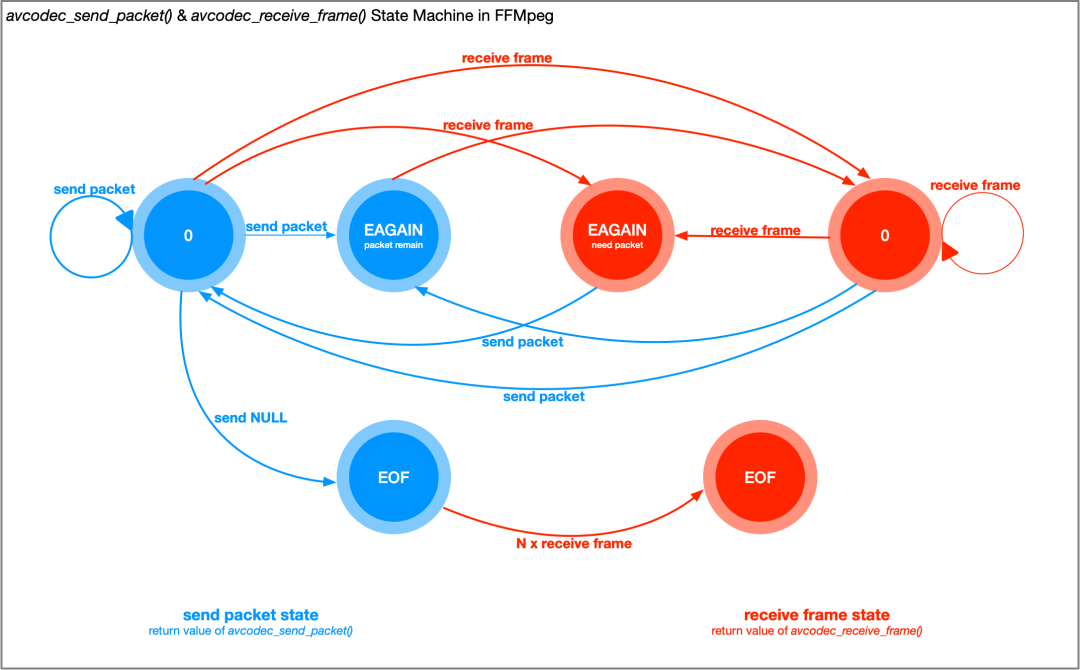背景
在优化视频客观全参考算法(主要是PSNR, SSIM, MS-SSIM)时,我们首先利用FFmpeg提供的API(avcodec_send_packet(),avcodec_receive_frame())对输入的两个MP4文件转成对应的YUV格式的数据文件,然后再基于这两份YUV数据文件进行计算,得到对应的结果。
但是,我们发现,MP4文件转成YUV数据后,总是会发生丢失视频最后几帧的现象。
为了弄清楚这个问题,查阅了FFmpeg的源码,并参考了网络上的资料,然后总结出了这篇文章。
FFmpeg的编解码API
从3.1版本开始,FFmpeg提供了新的编解码API来对音视频数据进行编解码操作,从而实现对输入和输出的解耦:
解码API
avcodec_send_packet()
avcodec_receive_frame()
编码API
avcodec_send_frame()
avcodec_receive_packet()
/**
* @ingroup libavc
* @defgroup lavc_encdec send/receive encoding and decoding API overview
* @{
*
* The avcodec_send_packet()/avcodec_receive_frame()/avcodec_send_frame()/
* avcodec_receive_packet() functions provide an encode/decode API, which
* decouples input and output.
* ...
*/同时,也正是从3.1版本开始,之前的编解码API也被标注为deprecated:
解码API
avcodec_decode_video2()
avcodec_decode_audio4():
编码API
avcodec_encode_video2()
avcodec_encode_audio2()
attribute_deprecated
int avcodec_decode_audio4(AVCodecContext *avctx, AVFrame *frame,
int *got_frame_ptr, const AVPacket *avpkt);在我们的工具中,我们采用了新的解码API:avcodec_send_packet()和avcodec_receive_frame(),实现视频帧的解码,并将解码后的数据转成YUV数据。具体的代码片段如下:
int process_frame() {
......
}
//decode operation.
while (!av_read_frame(fmt_ctx, pkt)) {
if (pkt->stream_index != video_stream_idx) {
continue;
}
int packet_new = 1;
while (process_frame(fmt_ctx, dec_ctx, video_stream->codecpar,
frame, pkt, &packet_new) > 0) {
i++;
};
av_packet_unref(pkt);
}从代码可以看出,i是解码帧的总数,但是我们运行之后发现,一个252帧的视频,最终只得到了248帧。
send_packet & receive_frame
为了加深对解码API的了解,以便能查出问题原因,我们查阅了FFmpeg的代码,从代码的注释中,我们发现了问题:我们没有遵循API的使用规范,同时FFmpeg在注释中也说明了为什么会出现我们遇到的问题。
/**
* ...
* At the beginning of decoding or encoding, the codec might accept multiple
* input frames/packets without returning a frame, until its internal buffers
* are filled. This situation is handled transparently if you follow the steps
* outlined above.
*
* End of stream situations. These require "flushing" (aka draining) the codec,
* as the codec might buffer multiple frames or packets internally for
* performance or out of necessity (consider B-frames).
* ...
*/也就是说,为了提升性能或出于其他的考虑,解码器会在内部缓存多个frames/packets。因此,当流结束的时候,需要对解码器执行flushing操作,以便获取解码器缓存的frames/packets。
我们的工具中,在流结束之后,并没有执行flushing操作,因此就出现了解码过程丢帧的现象。按照FFmpeg的指导,我们补充了如下的逻辑,以便获取解码器中缓存的帧。
//Flush remaining frames that are cached in the decoder
int packet_new = 1;
av_init_packet(pkt);
pkt->data = NULL;
pkt->size = 0;
while (process_frame(fmt_ctx, dec_ctx, video_stream->codecpar,
frame, pkt, &packet_new) > 0) {
i++;
packet_new = 1;
};再次运行,我们发现,丢帧问题消失了。
FFMPeg 解码 API 状态机
avcodec_send_packet返回值
从FFmpeg的源码中,我们会发现,正常情况下,avcodec_send_packet()函数的返回值主要有以下三种:
0: on success.
EAGAIN: input is not accepted in the current state - user must read output with avcodec_receive_frame() (once all output is read, the packet should be resent, and the call will not fail with EAGAIN).
EOF: the decoder has been flushed, and no new packets can be sent to it (also returned if more than 1 flush packet is sent).
avcodec_receive_frame返回值
同样的,正常情况下,avcodec_receive_frame()函数的返回值主要有以下三种:
0: success, a frame was returned.
EAGAIN: output is not available in this state - user must try to send new input.
EOF: the decoder has been fully flushed, and there will be no more output frames.
解码 API 状态机
avcodec_send_packet()和avcodec_receive_frame()不同的返回值代表了解码器的不同的状态。
对API的调用实际上是一种动作,而API的返回值则用来标志当前解码器的状态。因此,解码API的整个过程实际上就是一个状态机。
根据avcodec_send_packet返回值和avcodec_receive_frame返回值中的介绍,可以得到正常情况下,解码过程的状态机,如下图所示。

在图中,节点代表状态(API的返回值),箭头代表API的调用。蓝色表示和avcodec_send_packet()相关,红色表示和avcodec_receive_frame()相关。
我们修复版本的解码实现实际上就是对如上图所示的状态机的实现。
而如果在实现的时候,没有处理如下图所示的状态,则会导致无法获取视频最后几帧的问题。

思考 & 总结
源码面前,了无秘密。侯捷老师说过“源码面前,了无秘密”。工作中发现,源码确实是我们获取知识和经验的一个非常有效的途径,尤其是那些好的开源项目的源码,更是如此。
源码还是我们解决问题的强有力的手段之一。对于这些优秀的开源项目的源码而言,代码只是一个部分,源码中的注释、文档等会为我们提供足够的资源。这次问题的解决就是依赖源码,之前在Android摄像头Mock技术的研究中,也是在查阅Android相关源码后才有了思路。因此,当我们在工作中遇到问题的时候,第一手的资料还是源码(当然,要有源码才行),其次才是官方文档,最后才是网络上的其他资源。
看了那么多的源码才发现:优秀的项目是那么的一致,而糟糕的项目,各有各的糟糕之处。

技术交流,欢迎加我微信:ezglumes ,拉你入技术交流群。

私信领取相关资料
推荐阅读:
觉得不错,点个在看呗~





















 1820
1820











 被折叠的 条评论
为什么被折叠?
被折叠的 条评论
为什么被折叠?








